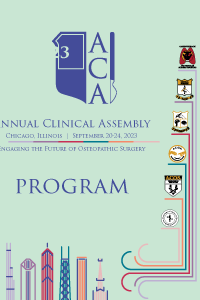General Surgery
A seemingly low risk patient develops urosepsis as a complication of transrectal prostate biopsy: A Case Study
- GO
Gabrielle I. Oquendo
Philadelphia College of Osteopathic Medicine Georgia
Peachtree Corners, Georgia, United States
Primary Presenter(s)
Prostate cancer (PCa) is the most common cancer in men, and the second leading cause of death due to cancer in the United States.1 Approximately 1 million Americans undergo prostate biopsies annually, with 97% undergoing the transrectal approach (Figure 1).2 While transrectal prostate biopsy (TRPB) is a reliable and relatively low-risk procedure, nearly 7% of patients develop infectious complications, with 3% requiring hospitalization due to sepsis.3 Risk factors for developing infection post-TRPB include antibiotic resistance, ≥18 biopsy cores, diabetes mellitus, indwelling catheter, and African-American ethnicity.4,5 Identifying risk factors and utilizing pre-procedural practices such as rectal sterilization, screening urinalysis, prophylactic antibiotic administration, or rectal culture can minimize infectious complications.4
Methods or Case Description:
A healthy 66-year-old Asian male, with family history of PCa, complains of worsening nocturia. He denies fever, fatigue, weight change, back or abdominal pain, hematuria, dysuria, polydipsia, or recurrent infection.
Vitals are normal, including body mass index (BMI). The prostate is enlarged and non-tender on digital rectal exam. His prostate-specific antigen rose to 5.8 from 2.4 in a year. Prostate MRI indicates high suspicion for cancer. Following rectal enema prep, urinalysis screen, and betadine sterilization, ultrasound-guided TRPB is performed. Antibiotic prophylaxis includes intravenous ciprofloxacin and ceftriaxone, and an additional three days of oral cefdinir. Twelve biopsies are sampled, and the patient is discharged home in good condition.The following evening, he develops fever, chills, and malaise. He is disoriented in the Emergency Department (ED), with a temperature of 101.2 Fahrenheit, blood pressure 150/82, heart rate 109, respiratory rate 24, and 94% oxygen saturation on room air. Urinalysis reveals leukocytes, blood, glucose, and protein. HbA1c is 6.4%. His condition improves with IV fluid resuscitation, empiric vancomycin and aztreonam in the ED, and meropenem during the remainder of his hospitalization. Peripheral blood cultures confirm pan-sensitive E. coli.
He is discharged home on oral cefuroxime 500mg BID for thirteen more days, and experiences no further complications. Prostate pathology reports confirms adenocarcinoma (Figure 2), for which he successfully completes radiation therapy.
Outcomes: *See discussion and conclusion-- outcomes included.*
Conclusion:
Recognizing risk factors and following proper infection prevention protocols are essential for minimizing potential TRPB-related complications. At first glance, our patient was seemingly low risk for post-procedural infection. However, a thorough retrospective review of the patient’s history brings into question whether his borderline-diabetic HbA1c level of 6.4% significantly contributed to his development of urosepsis.
Prediabetic ranges of HbA1c are 5.7-6.4%, with the patient’s level being just below the threshold for type II diabetes mellitus (HbA1c ≥ 6.5%). While it is well established that diabetes results in an immunocompromised state, recent research shows evidence of altered immune and inflammatory responses beginning in prediabetes as well. Based on these studies, compared to a normoglycemic population, prediabetic and diabetic populations presented with elevated levels of C-reactive protein (CRP), white blood cells (WBC), and IL-18–all markers of inflammation (Figures 3, 4, 5).7 This biochemical state of chronic inflammation is positively correlated with immune response dysregulation.8 Another study suggests a positive correlation between elevated glucose levels, beginning in prediabetic ranges, and the progressive impairment of phagocytic function of neutrophils.9
While these studies support that impaired glucose tolerance in the prediabetic range may render a degree of immunosuppression at the molecular level, further research is needed to explore prediabetes as a direct risk factor for post-procedural infectious complications. Depending on results from such a study, prophylactic strategies targeted to minimize TRPB-related complications in diabetics may need to be adopted for prediabetic patients as well.

